The project, known as MyFigueroa, will bring a bus-only lane and cycle tracks in Downtown and South Los Angeles. It is expected to provide a safer, more comfortable experience for pedestrians and cyclists, while maintaining vehicle access.
Community garden still going strong after five years
The music was blaring as residents walked the street fair on Raymond Avenue in South Los Angeles, on Saturday, to celebrate the saving of its community garden by the Los Angeles Neighborhood Land Trust and philanthropist Erika Glazer, along with the City and County of Los Angeles.
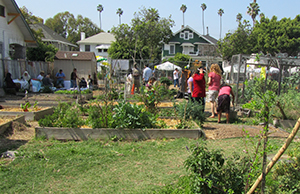 Erika J. Glazer Community Garden (Photo by Subrina Hudson)
Erika J. Glazer Community Garden (Photo by Subrina Hudson)A ceremony was held to announce the renaming of the the Raymond Avenue Community Garden to Erika J. Glazer Community Garden, and to unveil a new sign for the Glazer Garden, which was designed by its founder, resident Julie Burleigh.
Booths were set up along the street around the DJ for residents to receive information about everything from conserving water to making a worm compost.
Children lined up eager to get their face-painted, and many had their hand cupped around small, makeshift pot made out of newspaper.
“I planted beans,” said Melissa Ramirez.
The eight-year-old scooped dirt into her pot and planted her seeds, right before spraying some water on top of the fresh dirt.
 Melissa Ramirez (Photo by Subrina Hudson)
Melissa Ramirez (Photo by Subrina Hudson)Nkoli Udeorji, a volunteer with the grass-roots organization LA Green Grounds, stood behind a table to show other kids how to plant their seed of choice. She said being at the event is a great way to connect with the community.
“I thought we would bring the kids and let them run around,” said Karlyn Johnson, who heard about the event from another parent.
Johnson lives just a few blocks away from Raymond Avenue and said she had never known there was a garden so close to her residence.
“The more we can do stuff [like this] the more we can help the neighborhood,” said Johnson.
Julie Burleigh, who has lived in the neighborhood for 11 years, started the garden in 2008 out of a desire to be more involved in her community and create a space for growing food.
Inside, there are 35, squared-off plots. A total of 24 families grow their own food and plants, with some owning multiple pots.
Demand is high for a chance to own a plot said Burleigh, as she points to a waiting list on a table outside of the garden’s entrance. She said right now the garden is only available to the community gardeners, but she is looking to open it up for the whole community in the future.
Almost three years ago, Burleigh reached out for help to the Los Angeles Neighborhood Land Trust (LANLT), an organization that helps underserved communities develop and manage small parks and community gardens.
The 5,000 square-foot space that was being maintained by community gardeners was at risk of being taken away. The property owner owed $100,000 in back taxes, but LANLT was able to step in and also find philanthropist Erika Glazer.
Glazer donated $150,000 to pay off the taxes as well as upgrades to the garden.
Burleigh said she is surprised that the community garden has been able to survive.
“I’m also so surprised that an organization an come in and save it. It’s hard to manage a community garden – more failures than success,” she said. “It’s amazing…a total dream come true.”
“It’s a great way to be a part of the community and to get to know people and connect with people everyday,” said Burleigh.
9th District Candidate Closeup: Ana Cubas
White tennis shoes are a stark contrast to the jeans and black blazer worn by 9th District City Council hopeful Ana Cubas.
Talking with one of her aides, Cubas mentions that she is planning to walk door-to-door in order to cull more votes before the March 5 election. While social media has been a useful tool for her campaign, Cubas said getting out into the community and talking to people is her preferred plan of action.
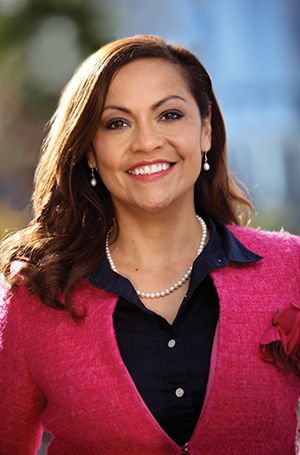 Photo courtesy of Ana Cubas campaign
Photo courtesy of Ana Cubas campaignWhen Cubas was 10 years old, she moved out of El Salvador and its escalating civil war to join her mother in Los Angeles. While her mother worked two jobs cleaning houses and office buildings and her father worked as a day laborer, Cubas would sit in the library with her sister every day after school until 6:30 p.m., when her mother would be done working.
Cubas credits her hours in the library as helping her get accepted into the University of California, Berkeley. Prior to her acceptance, she had never heard of Berkeley but after some prodding from her history teacher she applied. Cubas graduated from Berkeley with Highest Honors in Sociology, later pursuing a Master’s Degree at Princeton University.
She said her personal experiences coupled with her career as a public servant working in Washington D.C. for the Department of Education and in Sacramento, analyzing the state budget has influenced her decision to run for city council.
Intersections SouthLA: What can voters expect from you?
Ana Cubas: Number one is jobs and economic development. Our district needs good paying jobs. Two things when it comes to jobs and economic development – one, obviously, is to hold AEG and USC accountable for their major developments that are on the way. That’s the easy part, I think. The hard part is how do we in the southern part of the district, south of Adams, south of MLK, focus on making things better.
One of the things I’ve been working on is how to revitalize the vacant warehouses along Alameda and then San Pedro; if you walk even just a little bit you see all these vacant warehouses. How do we reactivate them to make them either do two things, become what is mixed-used where you have commercial and residential or, this is the side i’m most excited about, how do you create a specific plan…to build what I call a bio-med or clean tech corridor. You began to call and attract biomedical companies who want to locate here, and in fact, I know two already that I’ve talked to that are looking to move to L.A.
Third element is how do we help all our small businesses. How do we help them expand and grow and do better?
The second part of my platform is more green space. One of the commitments I have made is the Central Farm on 41st Street and Alameda is to basically convert that vacant land into a beautiful park and community garden. Also pocket parks, dog parks – whatever we can do to increase the amount of green space and green our commercial corridors with landscaped medians.
Education reform, because of my story, obviously, education is a key part of what I care about.
I’ve worked in city hall for over 14 years. I know the L.A. city budget very well. It’s a $7 billion budget – that’s bigger than most countries in the world. El Salvador, where I come from, their national budget is $3 billion. So, why is it that we have less than other areas? There’s nothing in the $7 billion budget that says, ‘Ok, there’s 15 districts. District 9 you get half of what the Westside gets.’ I’ve never seen a formula. It’s about leadership. It’s about fighting for resources. I’ve been lucky to have the endorsement of Councilwoman Rita Walters, and she and I are very in tune with this issue. It’s about being vigilant and making sure the bureaucracy of city hall, and it’s huge, is working for District 9.
Intersections: There’s been accusations that you have only recently moved into the district in an effort to gain a city council seat.
Cubas: So, the connection is my cousin my sister have lived here for 20 years. Remember, I was born in El Salvador until age 10, and then I went to college at age 18, so I only had eight years to live anywhere. It’s an unfair statement because I wasn’t born and raised here. If you see the constituents, I see them walk by, they remind me of my mom and dad. I remember when the new school year started, we never went shopping for clothes. I remember having a pair of white canvas tennis shoes and I used to clean them and put white paste on them and it hardened and they would break until you see a hole in the shoe. I am very much like the constituents of District 9 so it’s hard for me to understand those attacks.
Intersections: You’ve received some bad press around the redistricting of District 9. How do you plan to unit District 9 and the portion of what was District 11?
Cubas: I think the whole redistricting was blown out of proportion. Here I am, a woman of color, do you really think I had all that power to redraw the lines the way they were. Give me a break. There’s not that many women of color in city hall.
The redistricting commission had hundreds of hearings and the city council pretty much adopted the map the commission recommended. The issue was District 9, because of the immigration influx, had grown. So, technically, each council has to have 250,000 to 255,000 residents and these are just by population, whoever had been counted in the census. Now, from what I remember, CD9 had grown somewhere around 5 to 9 percent bigger, so they had more. So, somehow CD9 had to shrink. CD14 actually shrunk, and where did the growth happen – in downtown. So, CD9 had to shrink and CD14 had to grow so where did they look to? Downtown.
Intersections: Is there anything that you feel constituents in District 9 should know as they head to the polls?
Cubas: L.A. City Council has 15 members. Currently, Jan Perry is the only woman. All of my opponents are men. So, there’s a likely scenario that if I don’t win we will have an all-male council. There’s something wrong there [especially] a city of our magnitude of wealth and resources. I think that we need to pay attention to that because it means that we are being left out. Women pay taxes. We own our own businesses. We have the right to be at the table of power because men are making decisions for you as a women, in this city, they are making decisions for the children, and I think that it’s backwards.
Pan African Film and Arts Festival kicks off in South L.A.
By Subrina Hudson
Associate Editor
The 21st Pan African Film and Arts Festival opened on Thursday at the Baldwin Hills/Crenshaw Plaza giving residents and visitors in South LA a chance to view African art and watch films touching on the African and African-American community.
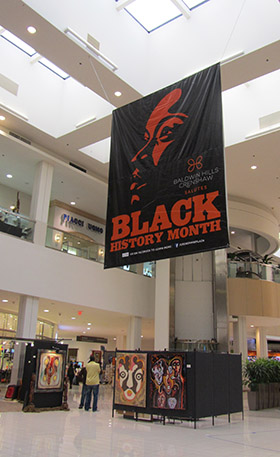 The art festival inside the Baldwin Hills/Crenshaw Plaza. (Photo by Subrina Hudson)
The art festival inside the Baldwin Hills/Crenshaw Plaza. (Photo by Subrina Hudson)The film festival, hosted by Actress Salli Richardson-Whitfield, is the largest international Black film festival in the country and features a 10-day long art festival with over 100 established and emerging artists showcasing everything from fine art and fashion to home furnishings.
Viveca Mays has been an artist for over 30 years, and said it was her first time showcasing her work at the art festival. After joining Art 2000, a non-profit visual art association founded by Artist Charles Bibbs, Mays said she was invited by Bibbs to present her work along with several other artists in the association.
“It has been very good considering that this is a regular mall day and everybody is doing their regular shopping,” said Mays. “We’ve had a lot of traffic coming through, which is surprising because Mr. Bibbs said usually the first day is kind of the work day, setting up, but it’s been good.”
Artist Djibril N’Doye said he has participated in the art festival for ten years but did not present for the last three years. During that time, the film festival was shown at a theater in Culver City and the art festival remained inside the mall, leaving less visitors and potential customers.
 Artist Viveca Mays’ artwork is open for the public to view and purchase. (Photo by Subrina Hudson)
Artist Viveca Mays’ artwork is open for the public to view and purchase. (Photo by Subrina Hudson)“This festival is important for this community and beyond because most of the theme of the films have a connection with Africa, African history and African culture and all the artists who are displaying their artwork also harken on the same subject…this is like family,” said N’Doye.
N’Doye, who is self-taught, creates his artwork with a ballpoint pen. Growing up in Senegal, his father could not afford to send him to an art school. So, N’Doye decided that he would teach and train himself.
He said his medium helps hims show that it doesn’t matter what an individual’s income is because art “is an open door to everybody.”
“It’s in your heat. It has a very high dimension and culture and history. This is building bridges across cultures,” he said.
 Artist Djibril N’Doye with his artwork. (Photo by Subrina Hudson)
Artist Djibril N’Doye with his artwork. (Photo by Subrina Hudson)The same goal was kept in mind for the Pan African Film Festival (PAFF), according to Wyllisa Bennett, publicist for the Pan African Film Festival.
“We want to stay in the community, and the films showcase the work around the country and puts it in the heart of the black community,” said Bennett.
Films like the documentary “Red, White, Black and Blue,” which recently won “Best Documentary at the Idyllwild CinemaFest, will be available for visitors to watch at the Rave Cinemas Baldwin Hills. “Red, White, Black and Blue” is just one of 154 films, representing 34 countries, that PAFF selected for this year’s film festival.
PAFF was founded in 1992 by award-wining Actor Danny Glover, Emmy-award winning Actress Ja’Net DuBois and Executive Director Ayuko Babu. The Pan African Film Festival is a non-profit corporation that looks to promote ethnic and racial respect through films and art.
For showtimes and tickets, click here.
Documentary on South LA rugby team receives a win
The documentary film, “Red, White, Black and Blue,” following students in a rugby program at a K-12 public charter school in South Los Angeles, won “Best Documentary” at the Idyllwild CinemaFest on Thursday.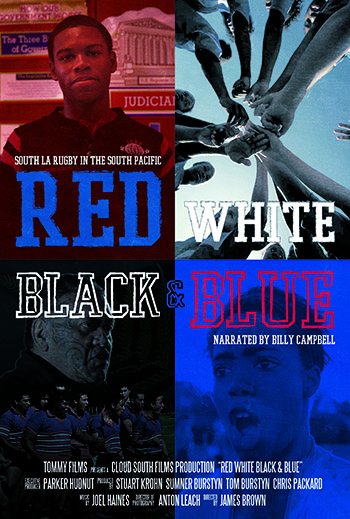
The film touches on the lives of 38 male and female high school rugby players, who participate in a rugby program at the Inner City Educational Foundation (ICEF) run by Director Stuart Krohn.
The rugby team traveled to New Zealand where they had the opportunity to learn about different cultures and dispel the negative views of South Los Angeles, while competing in rugby.
The program began ten years ago, and was started by Krohn, a former professional rugby player and English teacher. Over 4,000 students have been introduced to rugby through P.E. classes and after-school programs. Each year, 200 boys and girls compete on the tackly rugby teams, according to a statement by the ICEF Public Schools. Krohn organizes international trips for his players each year. Previous trips have allowed students to visit Hong Kong, England and South Africa.
“Rigby is a chance for our students to step outside the box and try something different. Our kids have the ability to suspend judgement and defy the stereotypes that other people might have of them,” said Krohn, in a statement.
The film will continue to appear in festivals around Southern California over the next several months. It will appear at the Pan African Film Festival at the Rave Baldwin Hills Plaza in Los Angeles on February 12, 2013.
For more information on the film, visit “Red, White, Black and Blue.”
Reconstitution and magnet convert at Crenshaw High draws protests
Parents, teachers and students held a press conference outside of Crenshaw High School on Monday to push back against a plan to magnet convert and reconstitute the South Los Angeles high school. 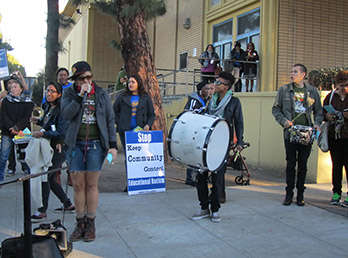
Community members are upset at LAUSD Superintendent John Deasy’s proposal to convert Crenshaw High School, including Orville Wright Middle School and Central Region Elementary School #20 (CRES 20), into a magnet school, and reconstitute Crenshaw High, which means all teachers and staff must re-apply for their jobs, according to parent Loutrisha Swafford.
Swafford questioned the necessity of having existing staff and teachers re-apply for positions they were already hired for.
“It doesn’t necessarily stabilize what we’re trying to build here. It destabilizes it,” said Averie Blackwell, student at Crenshaw High School. “It kills everything that we worked for. It doesn’t allow us to be students, to be free, to learn from the same teachers every single day. You know how hard it is to learn in a classroom that has a different teacher every single day?”
Supporters held signs with slogans like “Stop Educational Racism, Keep Community Control” and “Keep Our Schools Public,” while several students sang songs in protest as their peers played the drums.
“We have students here who are high-achievers because they’re coming through the streets filled with crime,” said Swafford.
Anita Parker, a senior at Crenshaw High School, said reconstitution would not help a school with already low resources. She said many lunch tables are broken and some classrooms are so full “you have to sit on the floor.”
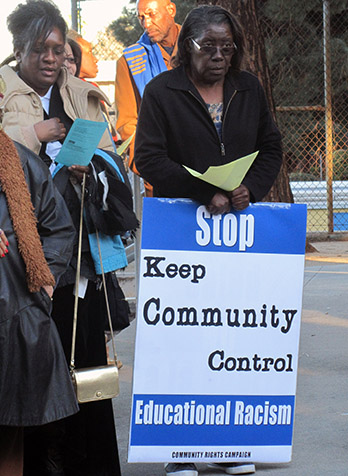 Those at the press conference expressed outrage at LAUSD for not consulting with parents, teachers, students and staff. According to Swafford, there was no prior knowledge or mention to the community by LAUSD of their intention to convert Crenshaw into a magnet school.
Those at the press conference expressed outrage at LAUSD for not consulting with parents, teachers, students and staff. According to Swafford, there was no prior knowledge or mention to the community by LAUSD of their intention to convert Crenshaw into a magnet school.
Swafford said the community is demanding that LAUSD reverse reconstitution and postpone any vote until further discussions are made with the community. They are also demanding support and resources for a recently implemented Extended Cultural Learning model from LAUSD.
The Extended Cultural Learning model offers a more well-rounded approach to curriculum, according to a statement by members of the school. The model focuses on cultural relevance, behavioral support and services, and outside activities like internships. Based on that model, the school was awarded a grant of $225,000 from the Ford Foundation.
By using the Extended Learning Cultural model, Swafford outlined a list of achievements made by students and staff. In 2011 – 2012, the school was able to improve its API by 15 points, including higher API levels among African-American students that were above six of the seven major South LA high schools.
Haewon Asfar, an organizer with the Community Rights Campaign, said the Extended Cultural Learning model showed improvements in more than just measurable ways. Many of her students in the after-school program she runs at Crenshaw feel more empowered and excited about coming to school.
“It has to be put within the context of their everyday lives…more than half are below the poverty line,” said Asfar, who also mentioned that many students come from single parent households. “It’s not the same conditions as other communities.”
New vision of Slauson Avenue in South Los Angeles
Residents in South Los Angeles gathered together Monday evening to share their fondest memories of being on Slauson Avenue, while proposing a vision of what they see Slauson becoming, at Junior Blind of America’s center.
The meeting, held in partnership with LA Commons and the Los Angeles County Arts Commission, was to help shape the development of the Slauson Corridor Revitalization Project, spearheaded by the Office of Supervisor Mark Ridley-Thomas. 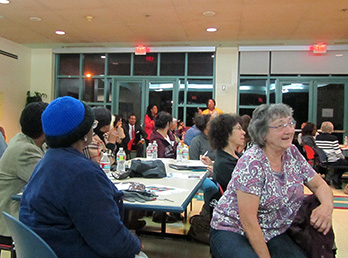
“I don’t want to go to Culver City to get a nice sandwich. I want to go right here, where we are and have a sense of pride in it,” said resident Roy Wheatle.
Everyone at the meeting agreed that they wanted the new Slauson Corridor, between Overhill Drive and Angeles Vista Boulevard, to offer more shopping and outdoor dining experiences, along with a pedestrian friendly atmosphere.
Karly Katona, deputy for sustainability for the office of Mark Ridley-Thomas, said making a livable, walkable community requires the input of its residents.
She said it was essential for those involved in the planning process to receive feedback from residents and local business owners to understand their needs and wants.
Erin Stennis, deputy to Supervisor Ridley-Thomas, added that it would have been impossible for the district to implement changes without feedback from the community. 
“This is a community that has traditionally been engaged,” said Stennis.
Supervisor Mark Ridley-Thomas said the revitalization is also an effort to “bring value to the land use and space.”
“My role is essentially one to catalyze the process, to attract attention to it and make investments into it with the resources of Los Angeles County,” said Ridley-Thomas.
He added that the project was not a publicly funded project, but one that uses the public’s input to help attract private investors.
“We are teeing this up in a way that is worthy of this environment…I don’t see that to be a pipe dream,” said Ridley-Thomas. “This is going to be an emerging market that will not be ignored.”
A portion of the meeting was dedicated to hearing development plans from student-led teams at USC and UCLA, as part of a real estate challenge organized by the National Association of Industrial and Office Properties (NAIOP) and sponsored by Ridley-Thomas.
The challenge is a 6-week case competition where students from both schools are tasked with solving a development issue, such as the Slauson Corridor.
This is the 15th year the challenge has taken place between UCLA and USC tied with 7 wins each, which makes the Slauson project a tie-breaker competition, according to Ridley-Thomas.
The winning team has not been announced, but residents applauded both schools for the research put into their presentation.
Both teams proposed a space that would seamlessly mix dining and retail shops with senior independent living.
USC proposed a two-story parking structure with multiple entrances for residents and visitors.
UCLA had surface level parking citing that many grocery stores preferred it to structured parking due to safety and its ease of access. 
For residents, the most anticipated portion of both presentations was hearing the possibility of specialty retail grocery store, Trader Joe’s, making its home inside the renovated corridor.
USC believed the area had the potential to attract Trader Joe’s.
While UCLA said based on their meetings with the company, it would be difficult and proposed building a Lazy Acres Market, an upscale grocery store chain operated by Bristol Farms, which caused some in the crowd to become upset.
Ridley-Thomas pointed out that it was important for residents to have not one but several choices in where they would like to shop.
The next meeting, discussing the environmental impact report for the Slauson Avenue streetscape, is scheduled to take place on Monday, Dec. 3 at 7 p.m. at Junior Blind of America.
Residents Line Up for Annual Turkey Giveaway
A line of people began forming as early as 8 a.m. on Monday, for a chance to receive a free Thanksgiving meal outside of Jackson Limousines’ fleet yard in South Los Angeles.
E.J. Jackson, founder and president of Jackson Limousine Service, was initially worried because donations were significantly low, but said corporate and local donations picked up before Tuesday’s giveaway.
“Walk by faith not by sight…I’d be lying if I told you I didn’t have any doubts, but I knew God would provide,” said Jackson, who has been giving away turkey dinners for the past 30 years.
Volunteers were lined up along a table bagging fresh produce such as broccoli, tomatoes, bell peppers and celery. The plastic bags were then placed into a cardboard box with other Thanksgiving items like a box of cornbread mix and stuffing. 
The frozen turkeys were still safely packed away.
“This helps me get in the holiday spirit by helping the less fortunate,” said South L.A. resident, T.J. Falls. “I have two jobs…I don’t mind volunteering because when you’re doing it from the heart you don’t get tired.”
Eve McCraw and Resee Coney were the first in line for Tuesday’s giveaway, arriving at the entrance at 8 a.m.
The two said it has been difficult to find help in South Los Angeles during the holiday season because many places have been cutting back on food donations.
“It’s a blessing,” said Coney.
McCraw said she has been receiving Thanksgiving dinners from Jackson since 2009 and every year, she has seen the crowd grow.
Over the last four years, a growing number of those waiting in line have been from cities outside of South L.A. like San Bernardino and Ontario, according to Fatty Jackson, organizer and nephew of E.J. Jackson.
Fatty continued that he has also seen the line start earlier each year with residents lining up one and even two days before the giveaway.
“It’s been more of a mixed crowd – all nationalities over the last four years. There’s more young mothers, single mothers and senior citizens,” said Fatty.
Jackson’s nephew has been volunteering for the past 17 years and helps ensure the donation process runs smoothly.
He said each year they have been able to speed up the process and prevent any confusion, especially with the help of the Los Angeles Police Department and the Los Angeles County Sheriff’s.
While donations have dropped over the last two years, he believes they will still be able to serve about 4,000 people.
He feels the reason the turkey giveaway is able to continue is because of his uncle’s passion for giving back to the community.
“Sometimes people don’t want to give because they don’t know where the money is going to, but with my uncle, you can see where it’s going,” said Jackson.
LAPD Announce Reward for Information on Tillett Murder
By Subrina Hudson
Associate Editor
The Los Angeles Police Department and city of Los Angeles announced a $50,000 reward on Thursday for anyone with information about the individuals responsible for the murder of Dennis Tillett, 24, on July Fourth in South Los Angeles.
“We need assistance on this,” said Sgt. Rudy Lopez. “We’re not calling it a cold case, but it’s still active.”
Lopez said the announcement of the reward at a press conference was made in hopes of reminding the community of what took place and emphasized that tipsters would have their identities protected.
 Tillett was celebrating the Fourth of July holiday with a group of people and standing outside a home on South Second Avenue, near Arlington Avenue and West 48th Street, when two male black suspects approached and began firing multiple gunshots toward the group.
Tillett was celebrating the Fourth of July holiday with a group of people and standing outside a home on South Second Avenue, near Arlington Avenue and West 48th Street, when two male black suspects approached and began firing multiple gunshots toward the group.
The suspects shot four people, including Tillett who was taken to a hospital but died from his injuries. The other three victims survived.
Dave Garrido, supervising detective, said they have not had any leads, but hope the reward will be an incentive for those with information to come forward.
With little information to move the case forward, the suspects still remain at-large and Garrido said he understands the community’s fear.
“We hope someone comes forward and identify the killer,” said Audrey Fletcher, Tillett’s mother.
It has been a daily struggle said Fletcher, who thinks about her son everyday. She said Tillett’s friends still call and text her to see how she is doing.
Tillett, who Fletcher describes as having a “bubbly” personality, would have celebrated his 25th birthday on October 15.
He had graduated from Morehouse College, a historically black, all-male school, in 2009. After spending a year searching for work, he was accepted into the management training program at Enterprise Rent-A-Car.
Fletcher said her son was just starting out. He had recently bought his own apartment and passed Enterprises’ management exam and was subsequently promoted to an assistant manager, after nine months.
Family and friends who were at the press conference described Tillett as a sociable person that knew how to cheer people up.
“He was always having a good time, always smiling and making jokes,” said Shedonna Burleson, his best friend.
Police said if anyone has information regarding the murder of Tillett and the person or persons responsible they are encouraged to contact Detective M. Applegate or Sgt. A. Burke, Criminal Gang Homicide Division, at (213) 485 – 4341 or on weekends and holidays at (877) 527 – 3247. Tips can also be sent via text message to 274637 with the word “LAPD” and your message.
Second chance for high school dropouts in South LA
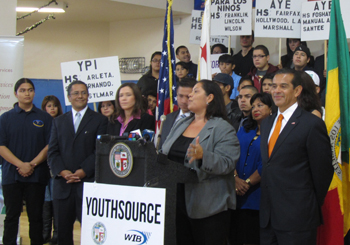 Mayor Antonio Villaraigosa unveiled 13 new YouthSource Centers on Friday with four of them located in South Los Angeles, and tasked with the goal of getting high school dropouts to finish their education.
Mayor Antonio Villaraigosa unveiled 13 new YouthSource Centers on Friday with four of them located in South Los Angeles, and tasked with the goal of getting high school dropouts to finish their education.
The Youth Source system is a redesign of Los Angeles’ OneSource Center, which previously focused on job searching efforts for in-school youth. Now, the agenda has shifted to get out-of-school youth back into school to receive their high school diploma or pass the General Educational Development (GED) test.
Mike Fong, east area director for the City of Los Angeles and senior liaison to Asian Pacific Islander community, said the criteria for where the centers would be placed was the “fairly high dropout rates” of high schools in the city.
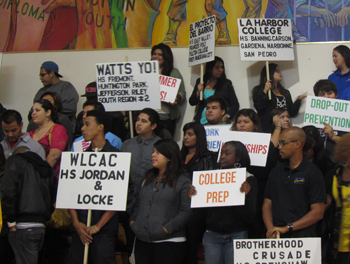 There were seven planning areas such as South L.A., and within those areas are one or several YouthSource centers. Fong said each center is operated by a non-profit organization.
There were seven planning areas such as South L.A., and within those areas are one or several YouthSource centers. Fong said each center is operated by a non-profit organization.
“It was a competitive process and raters looked at proposals and picked the best operators that would fulfill the need for the community,” said Fong.
In South LA, two centers are operated by Watts Labor Community Action Center and the others by Brotherhood Crusade and Archdiocesan Youth Employment.
Fong said each center services neighboring high schools and is employed with a full-time Pupil Services and Attendance Counselor who reaches out to out-of-school students from a list of high school dropouts. Students are also free to join the center themselves said Fong.
In order for students to become involved in the YouthSource program, they must be 16 to 21 years old, live in Los Angeles and be income eligible. Students are asked to be involved with the program for at least one year where they receive guidance on reenrolling in high school and various other services like work readiness and computer training.
Fong said the future of the YouthSource system is to decrease high school dropout rates and prepare students for college and work.
“This is really a second chance opportunity,” said Fong.
The system, managed by the City’s Community Development Department, was made possible through $13 million annually provided by the Federal Workforce Investment Act and a new $12 million grant from the Department of Labor’s Workforce Innovation Fund.
Michelle King, assistant superintendent at Los Angeles Unified School District said there are a variety of student recovery programs in place, but what differentiates the YouthSource Centers is the umbrella of services it provides students from family to financial concerns.
“It’s like a case worker. It’s not just to get them back in school, but to stay,” she said.
King said the dropout rate for LAUSD is at 24 percent, the lowest in five years, compared to its previous standing at 33 percent, and the high school graduation rate is 64 percent.














